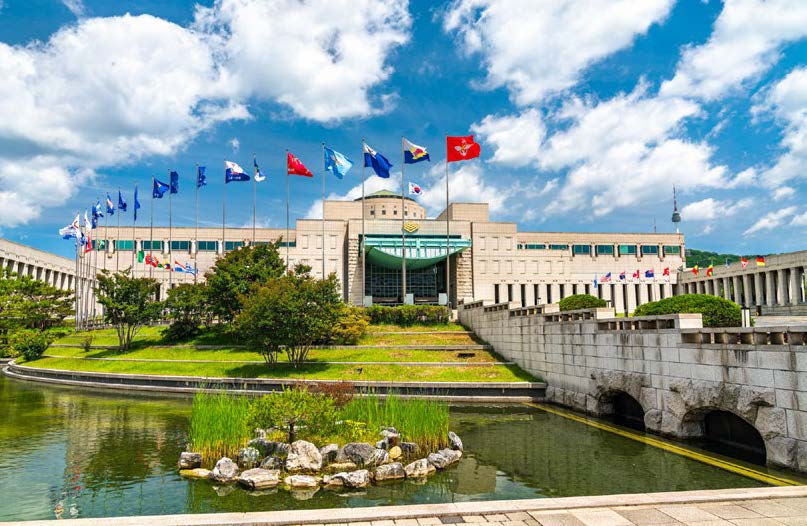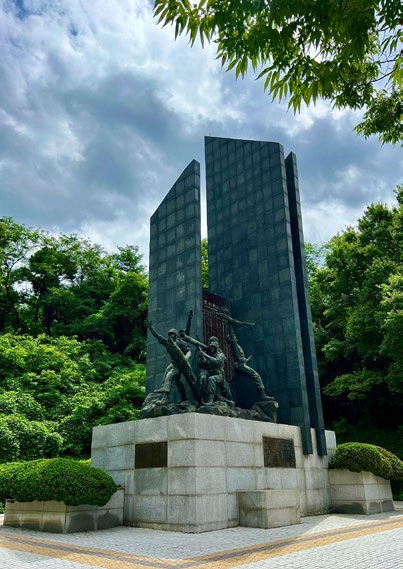The 75th Anniversary of the Korean War
- Cord A. Scott, Ph.D

- Jun 1
- 6 min read
Updated: Jul 26

This June 25th marks the 75th anniversary of the start of the Korean Conflict on the peninsula. One of the most asked questions is, “Why is it called a conflict or a police action, rather than a war?”
While the terminology can be debated, this milestone offers a significant opportunity to reflect on the Korean War’s historical impact, its ongoing legacy on the peninsula, and the broader Korean War timeline that shaped modern Northeast Asia.
For the purposes of this article, we’ll refer to it as a war, though officially, the U.S. government never declared it one through an act of Congress.
How the Division of Korea Set the Stage for War
So, how did this all come about? Who fought in the war? Why is it controversial to this day?
To understand the situation on the peninsula now, and why there are now two Korean countries, one has to go back to 1945. When U.S. and Soviet forces divided the peninsula at the 38th parallel, Korea's divided history began.
Korea at that time had been a colony of Japan, and following the end of World War II on August 15, 1945, Korea declared itself independent. However, being that they had been a colony, Allied forces had been asked to step in and occupy the area. Two US colonels, Dean Rusk (later Secretary of State under Presidents Kennedy and Johnson) and Charles Bonesteel (later commanding general of the 7th Infantry Division) drew the arbitrary line of the 38th parallel across the peninsula.
North of the line, Soviet troops would secure the area, while U.S. troops secured the area south of the line. At that time, most of the industry was located north of the line, while much of the south was agricultural in nature. This dividing line would be in place for the next five years.
The Rise of Kim Il-Sung and Syngman Rhee
The two men who eventually came to power in their respective areas wanted elections that would favor their own side. In the North, the Russian-educated Communist leader Kim Il-Sung was in power. He felt that the peninsula should be under communist control, and he eventually established the only dynastic government in a communist system. There are all sorts of issues with this, but it occurred.
In the South was a U.S.-trained doctor who eventually became the titular leader. Singman RHEE was his name, and he felt that an anti-communist system was best for Korea. For several years, there was a considerable amount of tension as both sides tried to influence local elections, often with violence and forms of coercion.
Global Tensions Escalate: Cold War Politics and the Korean Peninsula

By 1949, the Cold War between the U.S. and the U.S.S.R. was heating up with two significant events. First was the detonation of the first Soviet atomic bomb in August. Prior to this, only the U.S. had these weapons. The fact that the Soviets had the atomic bomb worried U.S. officials. Six weeks later, on October 1, Chinese leader Mao Zedong declared the People's Republic of China.
Now the world’s most populated country, and the largest country in size, were both communist, and both shared a border with Korea. By May of 1950, Kim was permitted by Soviet leadership to invade. The North Koreans were equipped by the Soviets, and their attack was launched on June 25, when many ROK troops were on leave.
These developments—China turning communist and the Soviet atomic bomb—escalated Cold War tensions in Asia, setting the stage for the peninsula to become a frontline.
June 25, 1950: North Korea Launches a Surprise Attack
The North Korean invasion of South Korea began just before dawn, catching ROK forces off guard. This initial attack was a complete surprise, and soon civilians and military alike were fleeing south. The South Korean government appealed to the United Nations Security Council—a decision that would lead to the first UN battle near Osan. As it happened, the Soviet Union was boycotting the U.N. at the time, and their representative, who could have vetoed the measure, was not there to vote. The U.N. announced that troops would be committed to the Korean peninsula to push the North Koreans back.
International Response: The UN and Allied Forces Step In
The role of the United Nations in the Korean War marked one of the first instances of a multinational military coalition under U.N. command. Eventually, 16 countries would commit troops and materiel to the fight including Canada, whose contributions were significant throughout the conflict. Read how Canadian troops played a vital role during the Korean War. Five more countries would send medical or humanitarian aid.
Among the many turning points in the war, the Battle of Inchon stands out for its strategic impact and unexpected success under General MacArthur’s command.
The Human Cost of the Korean War: Casualties and Civilian Impact

The conflict itself was chaotic for approximately six months, when fighting swept most of the peninsula. In the end, 38,000 US personnel were killed, close to 1 million combatants killed, 2-3 million civilians killed or displaced, and entire families split by the eventual truce called in July 1953 with some of the fiercest battles memorialized today along the Nakdong River. Explore the Chilgok-gun County memorials dedicated to these pivotal moments.
Why the Korean War Never Officially Ended: Armistice vs. Peace Treaty
As it was not a formal ceasefire, this has meant that the two sides are still technically at war, hence the reason U.S. troops are on the ROK. It is also a reason why the DMZ still is one of the most heavily guarded borders in the world.
The Korean War’s unresolved status continues to shape modern military posture, including the enduring presence of U.S. artillery. Learn more about the legacy of U.S. field artillery in Korea.
The 75th Anniversary of the Korean War: History, Legacy, and Commemoration
Over the next few months, we will take a few moments to note the major events of the month and point out the locations that people may visit, so that we remember the sacrifices of those who paid the ultimate price. As for a general overview of the war, one may want to visit the Korean War Memorials in South Korea, including the large facility in downtown Seoul One part of the building focuses on the war in its phases.
More Resources on the Korean War
To dive deeper into the history, legacy, and global impact of the Korean War, explore the following resources:
Featured External Resources
The Battle of Inchon: Turning the Tide Explore the strategic brilliance and lasting impact of the Battle of Inchon in this detailed article by the Marine Corps History journal.
Marine Corps University Press – The Battle of Inchon (Summer 2025)
The Korean War Legacy Project A comprehensive archive of interviews, lesson plans, and historical documents preserving Korean War
Korean War Veterans Memorial Foundation Learn about ongoing efforts to honor Korean War veterans and explore memorials across the U.S. and South Korea. koreanwarvetsmemorial.org
Related Articles from United on the RoK
75 Years Later: Honoring the UN Forces’ First Battle in Korea at Osan
Discover how the first major clash involving UN forces unfolded near Osan.
Canadian Valor: Honoring Canadian Soldiers in the Korean War—75 Years Later
A tribute to Canada’s vital contributions and sacrifices during the war.
The King of Battle: The Legacy of the United States Field Artillery
Explore how U.S. artillery shaped the battlefield and supported allied troops.
Along the Nakdong River: Korean War Memorials in Chilgok-gun County
Visit memorials that line the Nakdong River, where pivotal battles took place.
Honoring the Legacy: A Call to Remember
As we mark the 75th Anniversary of the Korean War, we are reminded not only of the sacrifices made but also of the lasting impact this conflict has had on the Korean Peninsula and the world. From the division of a nation to the resilience of its people, the Korean War continues to shape history and inspire future generations.
We encourage you to take this moment to reflect, learn, and honor those who served. Whether you explore a memorial site, attend a commemorative event, or simply share this article with others, your engagement helps keep these stories alive.
Take Action:
Visit a Korean War memorial near you or in Korea.
Share your family’s story or connect with a veteran.
Explore more resources and articles to deepen your understanding.
Leave a comment or share this article to keep the conversation going.
Whether you visit a memorial site, attend a commemorative event, or share this article with someone connected to the war, your engagement helps keep these stories alive.
Together, let’s ensure the legacy of those who fought in the Korean War is never forgotten—today, on its 75th anniversary, and for generations to come.
Frequently Asked Questions
What caused the Korean War to begin?
The war began on June 25, 1950, when North Korea launched a surprise invasion of South Korea across the 38th parallel.
Why is it called a conflict instead of a war?
The Korean War was never officially declared by the U.S. Congress, which is why it's often referred to as a "conflict" or "police action."
How many countries participated in the Korean War?
A total of 21 countries contributed troops or support under the United Nations flag, with 16 providing combat forces.
Why is the Korean War still technically ongoing?
An armistice was signed in 1953, but no peace treaty was ever finalized. North and South Korea remain technically at war.



Very informative.